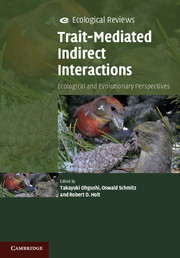Book contents
- Frontmatter
- Contents
- Contributors
- Foreword
- Preface
- Chapter One Introduction
- Part I Community
- Chapter Two Perspective
- Chapter Three Consequences of trait changes in host–parasitoid interactions in insect communities
- Chapter Four The impact of trait-mediated indirect interactions in marine communities
- Chapter Five Trait-mediated indirect interactions in size-structured populations
- Chapter Six Trait-mediated effects, density dependence and the dynamic stability of ecological systems
- Chapter Seven Plant effects on herbivore–enemy interactions in natural systems
- Chapter Eight The implications of adaptive prey behaviour for ecological communities
- Chapter Nine Community consequences of phenotypic plasticity of terrestrial plants
- Chapter Ten Model-based, response-surface approaches to quantifying indirect interactions
- Part II Coevolution
- Part III Ecosystem
- Part IV Applied Ecology
- Index
- Plate Section
- References
Chapter Seven - Plant effects on herbivore–enemy interactions in natural systems
Published online by Cambridge University Press: 05 February 2013
- Frontmatter
- Contents
- Contributors
- Foreword
- Preface
- Chapter One Introduction
- Part I Community
- Chapter Two Perspective
- Chapter Three Consequences of trait changes in host–parasitoid interactions in insect communities
- Chapter Four The impact of trait-mediated indirect interactions in marine communities
- Chapter Five Trait-mediated indirect interactions in size-structured populations
- Chapter Six Trait-mediated effects, density dependence and the dynamic stability of ecological systems
- Chapter Seven Plant effects on herbivore–enemy interactions in natural systems
- Chapter Eight The implications of adaptive prey behaviour for ecological communities
- Chapter Nine Community consequences of phenotypic plasticity of terrestrial plants
- Chapter Ten Model-based, response-surface approaches to quantifying indirect interactions
- Part II Coevolution
- Part III Ecosystem
- Part IV Applied Ecology
- Index
- Plate Section
- References
Summary
Introduction
While it had long been recognized that herbivores are simultaneously influenced by natural enemies (Hairston et al. 1960) and plant defences (Fraenkel 1959), Price et al. (1980) were among the first to argue forcefully that these dual factors must be considered together. They argued that ‘[w]e cannot understand the plant–herbivore interaction without understanding the role of enemies. We cannot understand predator–prey interactions without understanding the role of plants’ (Price et al. 1980, p. 59). This holistic, tritrophic perspective conceptually unites theory from at least three areas of ecological and evolutionary research. First, this tritrophic perspective expands our view on plant defence from one based strictly on the direct defence, to one that also considers the indirect defence of plants by natural enemies (Janzen 1966; Turlings et al. 1990), as well as how natural enemies mediate the efficacy of direct defences (Moran and Hamilton 1980; Clancy and Price 1987; Williams 1999; Gassmann and Hare 2005). Second, this tritrophic perspective advances our understanding of the forces shaping the evolution of herbivore host plant choice and diet breadth by incorporating the interactive effects of host plant quality and risk of attack by natural enemies (Bernays 1998; Singer et al. 2004a, b). And third, this tritrophic perspective provides a mechanistic framework for understanding the ecological and evolutionary factors that determine the strength of the indirect effects natural enemies have on plant growth, i.e., trophic cascades (Mooney et al. 2010).
Tritrophic interactions have received considerable attention in agricultural systems, with numerous studies documenting the effects of crop traits on herbivores and their natural enemies (Hare 1992; Tumlinson et al. 1992; Vet and Dicke 1992; Bottrell et al. 1998; Turlings and Benrey 1998; Cortesaro et al. 2000; Hare 2002; Ode 2006). In contrast, comparatively little is known of the influences of plant traits on herbivore–enemy interactions from natural systems (e.g., Hare 1992, 2002). Our goals in this review are three-fold. First, where past reviews on this topic have focused on agricultural systems (e.g., Hare 1992, 2002), we give special attention to the evidence for plant variation in herbivore–enemy interactions from natural communities. Second, we position this topic within the framework of trait- and density-mediated indirect interactions. Finally, we consider the evolutionary and ecological implications of plant variation in herbivore–enemy interactions, and we do so with specific reference to the different mechanistic pathways by which such plant effects can occur.
- Type
- Chapter
- Information
- Trait-Mediated Indirect InteractionsEcological and Evolutionary Perspectives, pp. 107 - 130Publisher: Cambridge University PressPrint publication year: 2012
References
- 20
- Cited by

